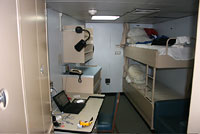

 | |||||||||||||||
|
|
Journals 2008/2009Jeff Lawrence
December 17, 2008 I spend a lot of my 12-hour shift on the deck helping to deploy the CTD and to gather water samples for analysis. After the CTD is back onboard, I am off to help gather the water samples for the Bigelow Labs group. We gather six two liter containers each time there is a cast and then take them into the main lab to filter for varying compounds which include organic and inorganic, organisms, chlorophyll, and hopefully coccolithophores. This process keeps Emily and me very busy. Emily Lyskowski is a lab technician working with Dr. Balch; she helps by filtering in the lab with the water samples collected from the CTD. Sometimes we are not even done with one sample before it is time to cock the bottles on the CTD and began gathering another sample. The CTD is the scientific instrument used the most onboard the REVELLE. It is deployed 4-7 times a day to gather data of the ocean's profile or water samples to be studied in the labs. The shift is packed with lots of activity. Matt Durham is always around to help deploy instruments off the ship. Matt Durham and Rob Pallomares work as the liaisons between the scientists and the ship's crew when instruments must go into the water. They are an important part of making the science happen. You will always see one or the other if not both when the CTD and other instruments are lowered into the ocean.
By midnight I have no trouble falling asleep aboard the ship even though it may be listing somewhat. The cabins or sleeping quarters are not large, but are adequate and comfortable as long as the ocean cooperates. Living aboard a ship is quite different from living on land. Your body must adjust to the constant moving of the ship. It moves in every direction, up and down, side to side, and both ways at the same time. Your legs have to adjust to the deck coming up to your feet and moving away. Going up and down stairs can be quite an adventure until you get accustomed to the movement. You always want to have three points of contact when the ship is listing. On land you just have two, you walk straight up and forward. On a ship three and sometimes four are needed. There are handrails all about the ship to help you keep your balance and keep moving. The passageways (hallways) are narrow and you must look ahead to allow others to pass through. We are instructed to keep all doors closed at all times when the ship is underway or someone could get hurt and possibly lose a finger or a hand.
Questions of the day:
|
||||||||||||||


